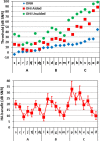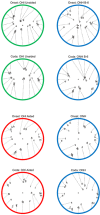Aided and unaided speech perception by older hearing impaired listeners
- PMID: 25730423
- PMCID: PMC4346396
- DOI: 10.1371/journal.pone.0114922
Aided and unaided speech perception by older hearing impaired listeners
Abstract
The most common complaint of older hearing impaired (OHI) listeners is difficulty understanding speech in the presence of noise. However, tests of consonant-identification and sentence reception threshold (SeRT) provide different perspectives on the magnitude of impairment. Here we quantified speech perception difficulties in 24 OHI listeners in unaided and aided conditions by analyzing (1) consonant-identification thresholds and consonant confusions for 20 onset and 20 coda consonants in consonant-vowel-consonant (CVC) syllables presented at consonant-specific signal-to-noise (SNR) levels, and (2) SeRTs obtained with the Quick Speech in Noise Test (QSIN) and the Hearing in Noise Test (HINT). Compared to older normal hearing (ONH) listeners, nearly all unaided OHI listeners showed abnormal consonant-identification thresholds, abnormal consonant confusions, and reduced psychometric function slopes. Average elevations in consonant-identification thresholds exceeded 35 dB, correlated strongly with impairments in mid-frequency hearing, and were greater for hard-to-identify consonants. Advanced digital hearing aids (HAs) improved average consonant-identification thresholds by more than 17 dB, with significant HA benefit seen in 83% of OHI listeners. HAs partially normalized consonant-identification thresholds, reduced abnormal consonant confusions, and increased the slope of psychometric functions. Unaided OHI listeners showed much smaller elevations in SeRTs (mean 6.9 dB) than in consonant-identification thresholds and SeRTs in unaided listening conditions correlated strongly (r = 0.91) with identification thresholds of easily identified consonants. HAs produced minimal SeRT benefit (2.0 dB), with only 38% of OHI listeners showing significant improvement. HA benefit on SeRTs was accurately predicted (r = 0.86) by HA benefit on easily identified consonants. Consonant-identification tests can accurately predict sentence processing deficits and HA benefit in OHI listeners.
Conflict of interest statement
Figures







Similar articles
-
Speech perception in older hearing impaired listeners: benefits of perceptual training.PLoS One. 2015 Mar 2;10(3):e0113965. doi: 10.1371/journal.pone.0113965. eCollection 2015. PLoS One. 2015. PMID: 25730330 Free PMC article.
-
Measuring consonant identification in nonsense syllables, words, and sentences.J Rehabil Res Dev. 2010;47(3):243-60. doi: 10.1682/jrrd.2009.04.0040. J Rehabil Res Dev. 2010. PMID: 20665350
-
Understanding excessive SNR loss in hearing-impaired listeners.J Am Acad Audiol. 2013 Apr;24(4):258-73; quiz 337-8. doi: 10.3766/jaaa.24.4.3. J Am Acad Audiol. 2013. PMID: 23636208
-
The effects of selective consonant amplification on sentence recognition in noise by hearing-impaired listeners.J Acoust Soc Am. 2011 Nov;130(5):3028-37. doi: 10.1121/1.3641407. J Acoust Soc Am. 2011. PMID: 22087930 Free PMC article.
-
The Association Between Cognitive Performance and Speech-in-Noise Perception for Adult Listeners: A Systematic Literature Review and Meta-Analysis.Trends Hear. 2017 Jan-Dec;21:2331216517744675. doi: 10.1177/2331216517744675. Trends Hear. 2017. PMID: 29237334 Free PMC article.
Cited by
-
Quality of life after intervention with a cochlear implant or hearing aid.Laryngoscope. 2016 Sep;126(9):2110-5. doi: 10.1002/lary.25848. Epub 2016 Jan 17. Laryngoscope. 2016. PMID: 26775283 Free PMC article.
-
Sounds of Nature and Hearing Loss: A Call to Action.Ear Hear. 2025 Mar-Apr 01;46(2):298-304. doi: 10.1097/AUD.0000000000001601. Epub 2024 Nov 7. Ear Hear. 2025. PMID: 39506198 Free PMC article.
-
Errors on a Speech-in-Babble Sentence Recognition Test Reveal Individual Differences in Acoustic Phonetic Perception and Babble Misallocations.Ear Hear. 2021 May/Jun;42(3):673-690. doi: 10.1097/AUD.0000000000001020. Ear Hear. 2021. PMID: 33928926 Free PMC article.
-
Underlying neural mechanisms of degraded speech intelligibility following noise-induced hearing loss: The importance of distorted tonotopy.Hear Res. 2022 Dec;426:108586. doi: 10.1016/j.heares.2022.108586. Epub 2022 Jul 22. Hear Res. 2022. PMID: 35953357 Free PMC article. Review.
-
The effect of motor resource suppression on speech perception in noise in younger and older listeners: An online study.Psychon Bull Rev. 2024 Feb;31(1):389-400. doi: 10.3758/s13423-023-02361-8. Epub 2023 Aug 31. Psychon Bull Rev. 2024. PMID: 37653280 Free PMC article.
References
-
- Kochkin S (2010) MarkeTrak VIII: Consumer satisfaction with hearing aids is slowly increasing. The Hearing Journal 63: 19–20,22,24,26,28,30–32 10.1097/1001.HJ.0000366912.0000340173.0000366976 - DOI
-
- Kuk F, Keenan D, Korhonen P, Lau CC (2009) Efficacy of linear frequency transposition on consonant identification in quiet and in noise. J Am Acad Audiol 20: 465–479. - PubMed
-
- Gordon-Salant S (1984) Effects of reducing low-frequency amplification on consonant perception in quiet and noise. J Speech Hear Res 27: 483–493. - PubMed
-
- Bilger RC, Wang MD (1976) Consonant confusions in patients with sensorineural hearing loss. J Speech Hear Res 19: 718–748. - PubMed
-
- Wang MD, Reed CM, Bilger RC (1978) A comparison of the effects of filtering and sensorineural hearing loss on patients of consonant confusions. J Speech Hear Res 21: 5–36. - PubMed
Publication types
MeSH terms
Grants and funding
LinkOut - more resources
Full Text Sources
Other Literature Sources
Medical
Miscellaneous

